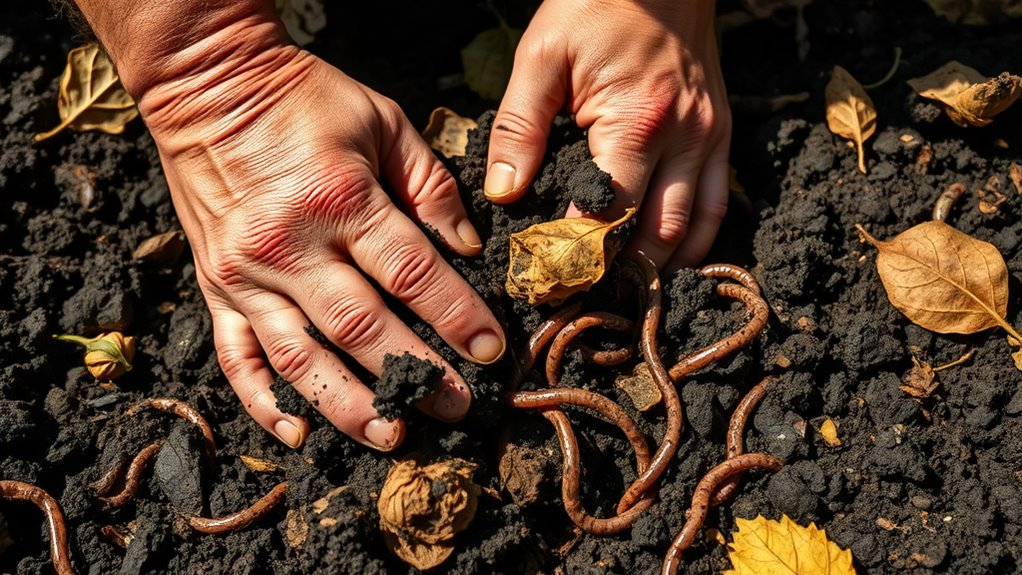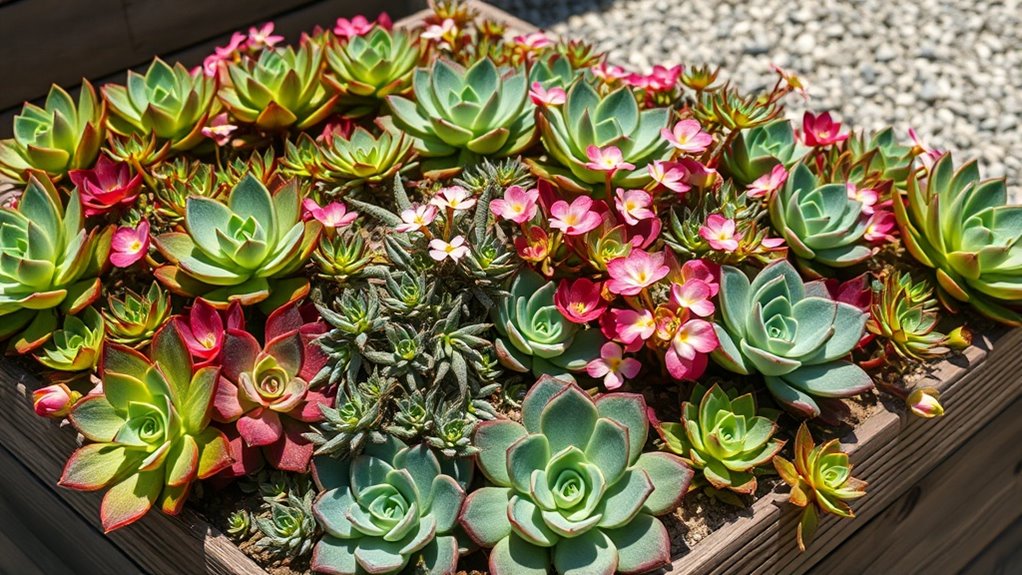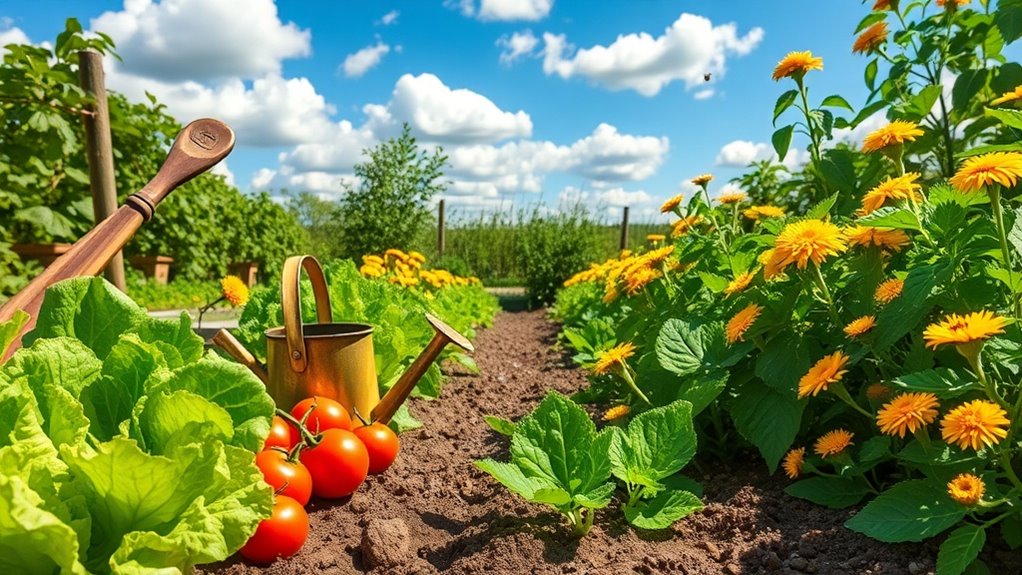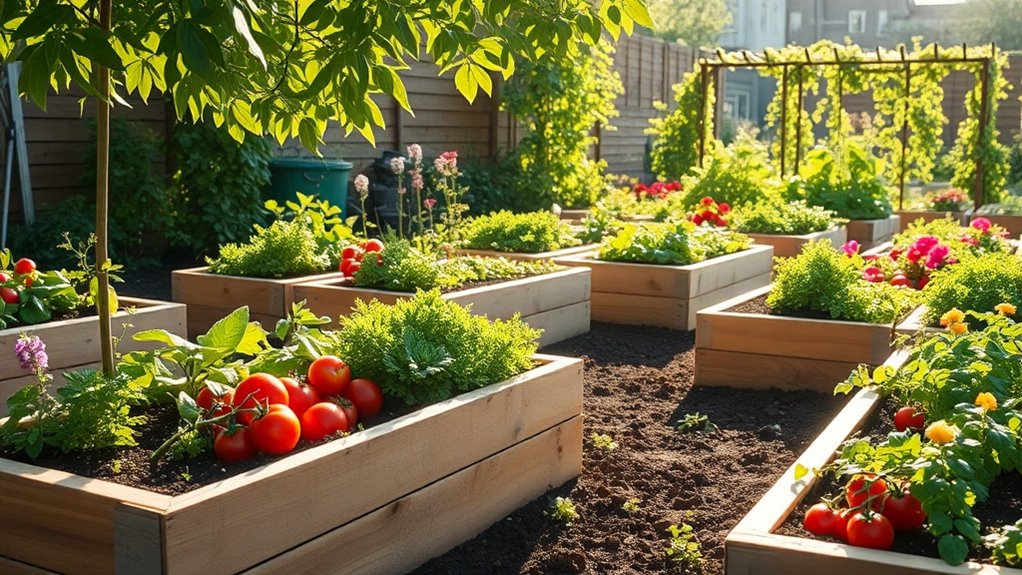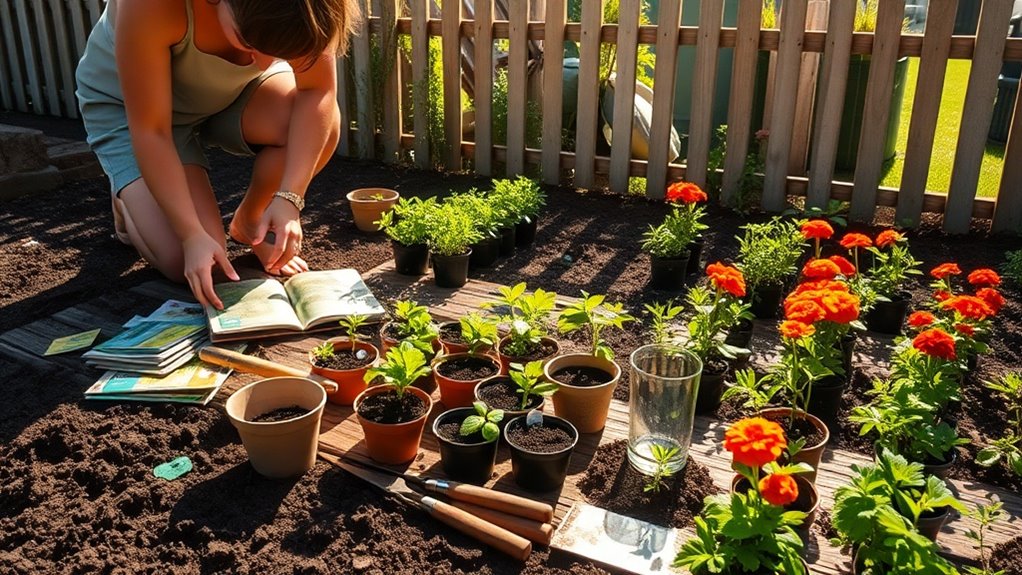How to Fix Bad Soil Without Buying Anything
You can fix bad soil without buying anything by first testing texture, pH, and drainage using simple household methods like the squeeze test or vinegar check. Compost kitchen scraps and yard waste to enrich fertility, turning them into nutrient-rich soil amendments. Mulch with fallen leaves to retain moisture and suppress weeds, while aerating compacted areas with a garden fork improves root growth. Plant cover crops from available seeds for natural enhancement. Explore these techniques further to master your garden’s health.
Key Takeaways
- Test soil by squeezing for texture and using vinegar or baking soda to check pH levels.
- Compost kitchen scraps and yard waste to create nutrient-rich amendments for soil.
- Mulch with fallen leaves or straw to retain moisture and suppress weeds naturally.
- Aerate compacted soil using a garden fork to improve root penetration and drainage.
- Monitor soil moisture with finger tests and adjust pH using available items like coffee grounds or wood ash.
Identifying Soil Problems in Your Garden
If your garden’s plants are struggling, it’s essential to identify soil problems before they worsen. This process involves soil testing to uncover underlying issues that may affect plant health.
You assess soil texture first—squeeze a handful to check if it’s sandy, clay-heavy, or loamy, as poor structure hinders root growth and affects soil improvement.
Test pH using natural indicators like vinegar or baking soda to detect acidity or alkalinity, which impacts nutrient uptake.
Evaluate drainage by observing water pooling; compacted soil restricts airflow and water movement.
These practical checks guide targeted soil improvement without purchases, preventing further plant decline through precise interventions.
Additionally, performing these evaluations can contribute to increasing crop yields by addressing soil issues early.
Composting With Household Waste
Composting with household waste transforms kitchen scraps and yard debris into nutrient-rich soil, enhancing your garden’s fertility without extra costs. You’ll collect organic materials like fruit peels, coffee grounds, and grass clippings, then build a pile in a sunny spot. Turn it weekly to maintain oxygen flow, ensuring even decomposition. Monitor moisture levels to keep it damp but not soggy, accelerating nutrient release. Incorporating these practices can further enhance soil health by recycling kitchen scraps and garden waste effectively. By utilizing everyday compost ingredients, you can also foster healthier plants while promoting a more sustainable approach to gardening.
Here’s a quick guide to effective composting:
| Household Waste | Composting Tips |
|---|---|
| Fruit and veg scraps | Chop small for quicker breakdown |
| Coffee grounds | Mix in for nitrogen boost |
| Grass clippings | Layer thinly to avoid clumping |
| Leaves and twigs | Shred first for faster decay |
Mulching Using Available Materials
Mulching with everyday materials, such as leaves or straw, protects your soil and boosts its health by retaining moisture and suppressing weeds.
You’ll gather these from your yard or nearby areas, ensuring they’re free of diseases. Apply a 2-4 inch layer around plants to minimize evaporation and block weed growth, which naturally breaks down to enrich the soil.
Use active techniques like turning the mulch periodically to aerate it, preventing compaction. This method conserves water and fosters beneficial microbes, making your soil more resilient without extra costs. By implementing this approach, you can keep your garden consistently moist throughout the growing season.
Monitor thickness to avoid excess, promoting optimal root health.
Moreover, mulching supports pest control by creating a protective barrier that discourages harmful insects, as seen in successful garden makeovers.
Incorporating Natural Amendments From Your Yard
You can boost your soil’s fertility by incorporating natural amendments from your yard, like decomposed leaves or grass clippings, to add essential nutrients and enhance texture. To optimize this process, consider ingredient swaps for more efficient decomposition and richer results.
Start by gathering yard waste such as fallen leaves or clippings, allowing them to break down into compost.
Then, dig these materials into your soil to a depth of 6-8 inches, promoting better drainage and aeration naturally.
You’ll enrich microbial life, which breaks down organic matter efficiently, improving nutrient availability.
Monitor your soil’s response; adjust amounts based on its current condition for optimal results, ensuring a sustainable, cost-free approach.
By utilizing these techniques, you can also explore backyard solutions for long-term soil health and environmental benefits.
Aerating Soil With Simple Tools
Aerating your soil with simple tools, such as a garden fork or spike aerator, loosens compacted layers to boost oxygen flow and water penetration.
This essential technique improves soil structure by increasing porosity, which enhances root respiration and moisture retention.
You’ll start by testing for compaction; insert the tool 6-12 inches deep and gently wiggle it to break up hard soil.
Work in a grid, spacing holes 4-6 inches apart for even coverage.
Perform aeration on moist soil, ideally in spring or fall, to prevent erosion.
Regular sessions promote microbial activity, ensuring better drainage and nutrient access for healthier plants.
This approach supports increased yield by naturally enhancing your harvest without relying on fertilizers.
Incorporating universal soil prep methods can help adapt this technique to various environmental conditions for optimal results.
Planting Cover Crops From Seeds You Have
Cover crops enhance soil fertility and structure by incorporating seeds you already possess, such as legumes or grasses that fix nitrogen and suppress weeds.
You’ll boost your soil’s health by planting these seeds directly, preventing erosion and adding organic matter naturally. These techniques can enhance your gardening experience while fostering a more sustainable approach to soil management.
-
Select seeds wisely: Identify viable seeds from your pantry or garden, like clover or rye, based on your soil’s needs for nitrogen fixation.
-
Prepare and sow: Till lightly if needed, then scatter seeds evenly in prepared beds during optimal seasons, ensuring good soil contact for germination.
-
Maintain coverage: Water moderately and weed around them until they’re established, promoting dense growth before incorporating into the soil.
This approach mirrors the bountiful harvest achieved through embracing organic methods in a personal gardening journey.
Monitoring and Adjusting Soil Conditions Naturally
You regularly monitor soil moisture using a simple probe or meter to keep it at optimal levels for plant growth.
If tests show your soil pH is too high or low, you adjust it naturally with amendments like compost or sulfur.
This proactive approach ensures your soil stays balanced and supports healthy ecosystems.
Monitor Soil Moisture
Monitoring soil moisture is essential for maintaining healthy soil, as it directly influences nutrient uptake and plant health.
You’ll need to assess it regularly using simple, natural methods to avoid imbalances that harm your plants.
Here are three practical techniques to monitor soil moisture effectively:
-
Finger test: Insert your finger 2-4 inches into the soil; if it feels dry, it’s time to water, but if moist, hold off.
-
Visual inspection: Check for cracks or a dusty surface indicating dryness, or observe water pooling as a sign of excess moisture.
-
Plant observation: Watch for wilting leaves or slowed growth, which signal inadequate moisture levels for adjustment.
Adjust Soil Ph
Soil pH influences nutrient absorption just as moisture does, so test yours regularly with simple tools like pH strips or natural indicators such as red cabbage extract.
To adjust pH naturally, first determine if it’s acidic (below 6) or alkaline (above 7). If acidic, add wood ash or crushed eggshells from your kitchen to raise it; for alkaline soil, incorporate pine needles or coffee grounds to lower it.
Mix these amendments thoroughly into the topsoil, water deeply, and retest after two weeks. This precise method ensures optimal nutrient availability, fostering healthy plant growth without any purchases, while you maintain soil balance effectively.

